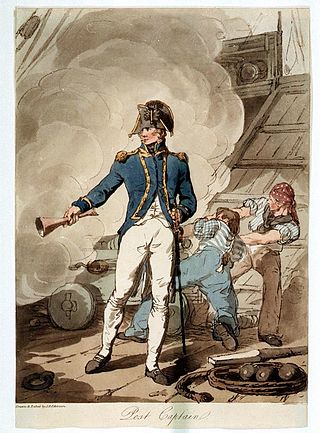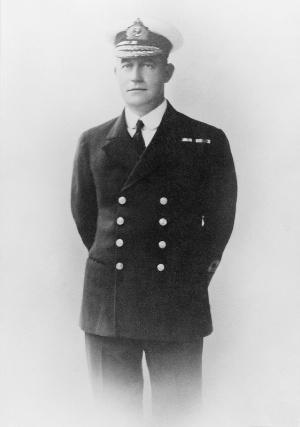| Master of the Fleet | |
|---|---|
 Ensign of the Royal Navy | |
| Admiralty | |
| Formation | c.1620 |
In the Royal Navy, the rank of master of the fleet denoted the sailing master of a fleet flagship, or the senior sailing master in a fleet.
| Master of the Fleet | |
|---|---|
 Ensign of the Royal Navy | |
| Admiralty | |
| Formation | c.1620 |
In the Royal Navy, the rank of master of the fleet denoted the sailing master of a fleet flagship, or the senior sailing master in a fleet.
Examples include John Bowen (master of the fleet during the Glorious First of June 1794), Ian Hogg, and John H. D. Cunningham. By 1814, the title granted the master extra pay. By 1832, the masters of the fleet were given the equivalent rank and uniform of commanders. By 1843, masters were appointed by commission not warrant. By 1864, the title was changed to "staff captain" and ranked after the regular rank of captain, while masters who had served at least 15 years were given the new rank of "staff commander" and ranked after commander. [1]
During the First World War the title was revived for the Grand Fleet's senior Navigation Officer.
The title has been used outside the Royal Navy, such as in Ultramarines and other science fiction, and for the captain of the Belle of Louisville .
Commodore is a senior naval rank used in many navies which is equivalent to brigadier or brigadier general and air commodore. It is superior to a navy captain, but below a rear admiral. It is either regarded as the most junior of the flag officers rank or may not hold the jurisdiction of a flag officer at all depending on the officer's appointment. Non-English-speaking nations commonly use the rank of flotilla admiral, counter admiral, or senior captain as an equivalent, although counter admiral may also correspond to rear admiral lower half abbreviated as RDML.
Commander is a common naval officer rank as well as a job title in many armies. Commander is also used as a rank or title in other formal organizations, including several police forces. In several countries this naval rank is termed frigate captain.

Post-captain, post captain, or postcaptain is an obsolete alternative form of the rank of captain in the Royal Navy.

The Royal Naval Reserve (RNR) is one of the two volunteer reserve forces of the Royal Navy in the United Kingdom. Together with the Royal Marines Reserve, they form the Maritime Reserve. The present RNR was formed by merging the original Royal Naval Reserve, created in 1859, and the Royal Naval Volunteer Reserve (RNVR), created in 1903. The Royal Naval Reserve has seen action in World War I, World War II, the Iraq War, and War in Afghanistan.
Captain general is a high military rank of general officer grade, and a gubernatorial title.
Fleet captain is a historic military title that was bestowed upon a naval officer who served as chief of staff to a flag officer.
Master commandant was a rank within the early United States Navy. Both the Continental Navy, started in 1775, and the United States Navy created by the United States Congress, in 1796, had just two commissioned ranks, lieutenant and captain. Master commandant, who would command smaller vessels, was used, unofficially, as early as 1799. The rank was made official in 1806. The name of the rank was changed to "commander" in 1837.

Admiral of the Fleet Sir Edward Beckwith Ashmore, was a senior Royal Navy officer. He saw active service in the Second World War and later commanded two frigates before achieving high command in the Navy. He served as First Sea Lord and Chief of the Naval Staff in the mid-1970s and in that role he advised the incoming Labour government on a major defence review and on the implications of the Turkish invasion of Cyprus. He went on to be acting Chief of the Defence Staff, serving briefly in a caretaker capacity following the death of his predecessor.
Commodore was an early title and later a rank in the United States Navy, United States Coast Guard and the Confederate States Navy, and also has been a rank in the United States Public Health Service Commissioned Corps and the National Oceanic and Atmospheric Administration Commissioned Officer Corps and its ancestor organizations. For over two centuries, the designation has been given varying levels of authority and formality.

Convoy commodore also known as commodore, convoys was the title of a civilian put in charge of the good order of the merchant ships in the British convoys used during World War II. Usually the convoy commodore was a retired naval officer or a senior merchant captain drawn from the Royal Naval Reserve. He was aboard one of the merchant ships. The convoy commodore was distinguished from the commander of the convoy's escort, always a naval officer.
In the uniformed services of the United States, captain is a commissioned-officer rank. In keeping with the traditions of the militaries of most nations, the rank varies between the services, being a senior rank in the naval services and a junior rank in the ground and air forces. Many fire departments and police departments in the United States also use the rank of captain as an officer in a specific unit.

A five-star rank is the highest military rank in many countries. The rank is that of the most senior operational military commanders, and within NATO's standard rank scale it is designated by the code OF-10. Not all armed forces have such a rank, and in those that do the actual insignia of the five-star ranks may not contain five stars. For example: the insignia for the French OF-10 rank maréchal de France contains seven stars; the insignia for the Portuguese marechal contains four gold stars. The stars used on the various Commonwealth of Nations rank insignias are sometimes colloquially referred to as pips, but in fact either are stars of the orders of the Garter, Thistle or Bath or are Eversleigh stars, depending on the wearer's original regiment or corps, and are used in combination with other heraldic items, such as batons, crowns, swords or maple leaves.

Admiral Sir George Francis Hyde, was an English-born Australian admiral, known as a former head and the first officer to achieve the rank of full admiral in the Royal Australian Navy.
Commander (Cdr) is a senior officer rank of the Royal Navy of the United Kingdom. It is immediately junior to captain and immediately senior to the rank of lieutenant commander. Officers holding the junior rank of lieutenant commander are not considered to be commanders.

Captain (Capt) is a senior officer rank of the Royal Navy. It ranks above commander and below commodore and has a NATO ranking code of OF-5. The rank is equivalent to a colonel in the British Army and Royal Marines, and to a group captain in the Royal Air Force. There are similarly named equivalent ranks in the navies of many other countries.

In the United States, commander is a military rank that is also sometimes used as a military billet title—the designation of someone who manages living quarters or a base—depending on the branch of service. It is also used as a rank or title in non-military organizations, particularly in law enforcement.

The master, or sailing master, is a historical rank for a naval officer trained in and responsible for the navigation of a sailing vessel.
Staff captain is the English translation of a number of military ranks:
Admiral Deshamanya D. Basil Gunasekara was the Commander of the Sri Lanka Navy from 1973 to 1979.